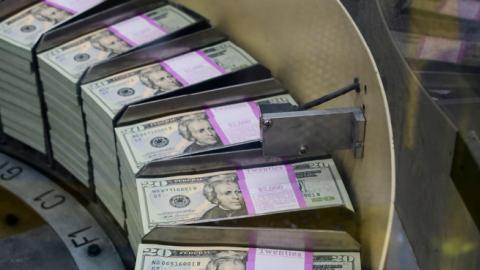Our current super-long economic cycle is a monetary curse. Under sound money it would not exist, and under the pre-1914 gold standard, it never occurred. The present business cycle expansion in the US — the longest ever — comes in the wake of three recent super-cycle expansions: 1991-2000, 1982-90, and 1961-69. Arguably, the first super-long cycle was in the early years of the Federal Reserve, from 1921-9.
What is the “secret of long life” for these business cycle expansions? It is repeated stimulation by the Fed in response to any sign of economic slowdown and related danger. Any downward natural rhythm of prices (sometimes misleadingly described as “disinflationary forces”) boosts the scope for central-bank stimulation at any stage of the business cycle (whether to accelerate recovery from a trough or in combating potential weakness later).
The downward rhythm could stem from a bout of technological change (in this cycle: technological changes) including globalization putting direct downward pressure on costs or a surge of productivity growth. Where the monetary regime is pursuing a price or inflation target, the downward rhythm means that the central bank can engage in “stimulation” rather than allow prices widely to fall as would occur in the context of sound money.
Under the pre-1914 gold standard, by contrast, periods of sustained price falls across goods and services markets (including business cycle recessions) were an essential part of the process by which goods and services prices on average in the long run reverted to the mean. Confidence among the public in that reversion was fundamental to money’s reputation as a store of value.
In the fiat money world, any pull-back in goods prices is an opportunity for monetary stimulus. Seizing that opportunity is essential to the generation of the long cycle. The ultimately highly destructive by-product of stimulus under these conditions is asset inflation. In the present cycle, there has been unprecedented opportunity.
The building blocks of the super-long cycle are the sub-cycles described as “growth cycles.” The sustained periods of above-trend growth (around 2 years on average since the 1950s) are labeled "growth cycle upturns" and of below trend as "growth cycle downturns" or growth recessions (slightly less than 2 years on average). The Fed has been determined on many an occasion, not always with success, to use its stimulus tools to prevent a growth cycle downturn developing into a full recession.
According to the Economic Cycle Research Institute, there have been already three completed growth cycles in the present super-long business cycle. We are now in the downturn phase of the fourth (from its peak in April 2018).
Since early this year the Powell Fed has been on the job of combating the downturn and President Trump has a key interest in their success. The extent of recessionary forces (including chickens coming home to roost from earlier monetary inflation) could be stronger than what any of these Fed officials now estimate (and too great for any fine-tuning to impact). Or they may miscalculate and do too little too late.
"Long Cycles" of the Past
We can turn to the laboratory of history for enlightenment.
First, there is the long cycle of 1921-9 (broken by a very mild recession from October 1926 to November 1927 which is more akin to growth cycle downturn than a significant recession). The Benjamin Strong Fed took advantage of disinflation from rapid productivity growth and global commodity glut to re-ignite the boom and give the faltering stock market a “coup de whiskey.”
When it came to the next growth cycle downturn emerging in late 1928/early 1929 the Fed under new leadership was now determined to crack the speculative craze in Wall Street. President Hoover (inaugurated March 1929) agreed. In any case there was no concern in the Fed or marketplace about a possible serious slowdown notwithstanding foggy recessionary signals from Germany since Autumn 1928.
Second, take the long cycle of 1961-9. Record productivity growth in the early 60s was a powerful “disinflationary” influence, allowing the Fed to run an aggressive stimulatory policy without the CPI rising (almost flat until 1965). Asset inflation was virulent. Belatedly, the Martin Fed reacted in Winter 1965/6 to a sudden jump in reported inflation, but lost its nerve as the economy slowed sharply, the equity markets started to tank, and the Johnson White House piled the pressure on. There was the notorious stimulus imparted by the Martin Fed in Winter 1966-7. The stimulus set the stage for a powerful economic rebound into 1967-8; in the midst of the Vietnam War and slowing productivity growth CPI inflation took off.
Third, the long cycle expansion of 1982-90 features the great monetary stimulus of Paul Volcker when he cooperated with President Reagan’s new Treasury Secretary, James Baker, in devaluing the dollar. The notorious Plaza accord (Autumn 1985) came in the middle of a difficult growth cycle downturn ahead of crucial mid-term elections (November 1986). The subsequent strong economic upswing of the late 1980s was marred by resumed high inflation and asset inflation around the globe (Japan the epicenter).
Fast forward to the present long cycle expansion (skipping through the Greenspan Fed’s repeated re-ignition of the expansion in the long 1990s cycle whether in 1995/6 or 1998).
The Bernanke Fed responded to the growth cycle downturn of February 2012 to January 2013 (the mover was the European sovereign debt crisis) with radical monetary stimulus. The next growth cycle slowdown, December 2014 to May 2016, (energy bubble burst, China “recession”) was met by the Yellen Fed scrapping all pre-planned rate rises for almost an entire year (2016) and foreign central banks engaging in enhanced monetary radicalism (QE and negative rates for example in Europe and Japan). Powerful disinflation globally (especially commodity glut and digitalization) made all this possible without jettisoning the 2 per cent inflation standard.
Then we come to the fourth growth cycle slowdown which ECRI dates from Spring 2018, led by the emerging markets (including China) and Europe. The Powell Fed, convinced that the big business tax cuts and de-regulation would triumph over any recessionary forces from abroad, continued at first with pre-ordained rate rises. Now with disinflation continuing and more recognition that despite everything the US is indeed in a growth cycle downturn, these have ceased.
During the early months of this year the dominant view in the marketplace has been that “Fed action” will be successful in forestalling the passage of the current growth cycle downturn into recession and that a new growth cycle upturn will indeed emerge by Winter 2019/2020. There is hardly any noticeable anxiety that this next growth cycle upturn will be accompanied (unlike recent previous growth cycle upturns) by a serious uptick of reported goods and services inflation. Yet who can be so sure? Downward price pressure from digitalization could suddenly ease. The extent of monetary inflation overhang in goods and services markets is unknowable.



















